Economic and Technical Aspects of Flexible Storage Photovoltaic Systems in Europe
Abstract
1. Introduction
1.1. Change in the Spread of Photovoltaic (PV) Technology in Europe
1.2. Change in the Spread of Energy Storage
- renewables capacity firming;
- renewables energy time shift;
- onsite renewable generation shifting;
- electric energy time shift;
- electric bill management;
- frequency regulation;
- voltage support;
- electric supply capacity.
2. Methods and Details of the Technical and Economic Assessment
2.1. Meteorological Background
2.2. Technological Background
- Absorbent Glass Mat, Absorbent Glass Mat (AGM);
- Aqueous Hybrid Ion, AHI—salt water;
- Lithium-Ion, Li-ion (lithium manganese oxide, nickel-cobalt manganese or lithium nickel manganese cobalt oxide;
- Lithium-Iron-Phosphate, LiFePO4;
- Olivine-type-Lithium-Iron-Phosphate, Olivine-type-LiFePO4;
- Vented lead-acid battery, OPzS;
- Sealed lead-acid battery, OPzV.
- PV modules;
- PV-inverter;
- battery-inverter;
- battery;
- battery remote control;
- energy manager system;
- frame on roof;
- cable with outlets;
- additional electric outfit;
- costs of design;
- installation and transportation.
- We determined the monthly total energy data.
- For our calculations we assumed 50% direct PV energy (as daytime use) usage based on the average electricity consumption of households (Table 3) with smart regulation.
- For the rest of the energy consumption, the battery energy usage (as evening use) was calculated considering the Depth of discharge (DOD) and the system losses.
- We assumed that if the flexible storage annual energy production of a PV system is more than the average electricity consumption, and the extra PV energy will result in extra revenue by the delivery price.
- On the other hand, if the PV or battery energy production level is too low, direct energy consumption from the grid is taken into account.
2.3. Economic Background in the Analyzed Countries
3. Economic Aspects of the Flexible Storage PV Systems
- Olivine-type-LiFePO4;
- Lithium-Ion;
- OPzS;
- AHI;
- OPzV (It has only positive NPV in Germany).
4. Conclusions
Author Contributions
Acknowledgments
Conflicts of Interest
Abbreviations
| AGM | Absorbent Glass Mat |
| AHI | Aqueous Hybrid Ion |
| DOD | Depth of discharge |
| DPP | Discounted payback period |
| GHI | Global horizontal irradiation |
| LiFePO4 | Lithium-Iron-Phosphate |
| Li-ion | Lithium-Ion |
| m-Si modules | Monocrystalline modules |
| NPV | Net present value |
| NREL | National Renewable Energy Laboratory |
| Olivine-type-LiFePO4 | Olivine-type-Lithium-Iron-Phosphate |
| OPzS | Vented lead-acid battery |
| OPzV | Sealed lead-acid battery |
| PG&E | Pacific Gas & Electric |
| PGIS | Photovoltaic Geographical Information System |
| PI | Profitability index |
| p-Si modules | Polycrystalline modules |
| PV | Photovoltaic |
| SCE | Southern California Edison |
| SDG&E | San Diego Gas & Electric |
| SGIP | Self-Generation Incentive Program |
References
- Zafar, R.; Mahmood, A.; Razzaq, S.; Ali, W.; Naeem, U.; Shehzad, K. Prosumer based energy management and sharing in smart grid. Renew. Sustain. Energy Rev. 2018, 82, 1675–1684. [Google Scholar] [CrossRef]
- Zame, K.K.; Brehm, C.A.; Nitica, A.T.; Richard, C.L.; Schweitzer, G.D., III. Smart grid and energy storage: Policy recommendations. Renew. Sustain. Energy Rev. 2018, 82, 1646–1654. [Google Scholar] [CrossRef]
- Kordmahaleh, A.A.; Naghashzadegan, M.; Javaherdeh, K.; Khoshgoftar, M. Design of a 25 MWe Solar Thermal Power Plant in Iran with Using Parabolic Trough Collectors and a Two-Tank Molten Salt Storage System. Int. J. Photoenergy 2017, 2017, 1–11. [Google Scholar] [CrossRef]
- Noman, A.M.; Addoweesh, K.E.; Alolah, A.I. Simulation and Practical Implementation of ANFIS-Based MPPT Method for PV Applications Using Isolated Ćuk Converter. Int. J. Photoenergy 2017, 2017, 1–15. [Google Scholar] [CrossRef]
- Daliento, S.; Chouder, A.; Guerriero, P.; Pavan, A.M.; Mellit, A.; Moeini, R.; Tricoli, P. Monitoring, Diagnosis, and Power Forecasting for Photovoltaic Fields: A Review. Int. J. Photoenergy 2017, 2017, 1–13. [Google Scholar] [CrossRef]
- Cucchiella, F.; D’Adamo, I. A Multicriteria Analysis of Photovoltaic Systems: Energetic, Environmental, and Economic Assessments. Int. J. Photoenergy 2015, 2015, 1–8. [Google Scholar] [CrossRef]
- D’Adamo, I.; Miliacca, M.; Rosa, P. Economic Feasibility for Recycling of Waste Crystalline Silicon Photovoltaic Modules. Int. J. Photoenergy 2017, 2017, 1–6. [Google Scholar] [CrossRef]
- Fraunhofer Institute for Solar Energy Systems (ISE). Annual Report 2016/2017; Fraunhofer Institute for Solar Energy Systems ISE: Freiburg, Germany, 2017; pp. 1–88. [Google Scholar]
- Fraunhofer Institute for Solar Energy Systems (ISE). Photovoltaics Report; Fraunhofer Institute for Solar Energy Systems ISE: Freiburg, Germany, 2017; pp. 1–45. [Google Scholar]
- Panagea, I.S.; Tsanis, I.K.; Koutroulis, A.G.; Grillakis, M.G. Climate Change Impact on Photovoltaic Energy Output: The Case of Greece. Adv. Meteorol. 2014, 2014, 1–11. [Google Scholar] [CrossRef]
- REN21. Renewable Energy Policy Network for the 21st Century Renewables 2017; Global Status Report—REN21; REN21: Paris, France, 2017; pp. 1–302. [Google Scholar]
- International Renewable Energy Agency (IRENA). Solar PV in Africa: Costs and Markets; IRENA: Abu Dhabi, UAE, 2016. [Google Scholar]
- China National Energy Board. 2016 Photovoltaic Power Generation Statistics. Available online: http://www.nea.gov.cn/2017-02/04/c_136030860.htm (accessed on 4 February 2018).
- Eurostat. Infrastructure—Electricity—Annual Data. Available online: http://ec.europa.eu/eurostat/en/web/products-datasets/-/NRG_113A (accessed on 4 February 2018).
- European Commission. EU Reference Scenario 2016; EC: Brussels, Belgium, 2016. [Google Scholar]
- National Renewable Energy Laboratory (NREL). Exploration of High-Penetration Renewable Electricity Futures; NREL: Golden, CO, USA, 2012; Volume 1.
- National Renewable Energy Laboratory (NREL). Renewable Electricity Generation and Storage Technologies; NREL: Golden, CO, USA, 2012.
- Sandia National Laboratories DOE Global Energy Storage Database. Available online: https://www.energystorageexchange.org/projects/data_visualization (accessed on 2 May 2018).
- Bertsch, J.; Growitsch, C.; Lorenczik, S.; Nagl, S. Flexibility in Europe’s power sector—An additional requirement or an automatic complement? Energy Econ. 2016, 53, 118–131. [Google Scholar] [CrossRef]
- Hesse, H.; Schimpe, M.; Kucevic, D.; Jossen, A. Lithium-Ion Battery Storage for the Grid—A Review of Stationary Battery Storage System Design Tailored for Applications in Modern Power Grids. Energies 2017, 10, 2107. [Google Scholar] [CrossRef]
- Schimpe, M.; Piesch, C.; Hesse, H.; Paß, J.; Ritter, S.; Jossen, A. Power Flow Distribution Strategy for Improved Power Electronics Energy Efficiency in Battery Storage Systems: Development and Implementation in a Utility-Scale System. Energies 2018, 11, 533. [Google Scholar] [CrossRef]
- Aneke, M.; Wang, M. Energy storage technologies and real life applications—A state of the art review. Appl. Energy 2016, 179, 350–377. [Google Scholar] [CrossRef]
- Han, X.; Liao, S.; Ai, X.; Yao, W.; Wen, J. Determining the Minimal Power Capacity of Energy Storage to Accommodate Renewable Generation. Energies 2017, 10, 468. [Google Scholar] [CrossRef]
- Blanco, H.; Faaij, A. A review at the role of storage in energy systems with a focus on Power to Gas and long-term storage. Renew. Sustain. Energy Rev. 2018, 81, 1049–1086. [Google Scholar] [CrossRef]
- Strbac, G.; Aunedi, M.; Pudjianto, D.; Djapic, P.; Teng, F.; Sturt, A.; Jackravut, D.; Sansom, R.; Yufit, V.; Brandon, N. Strategic Assessment of the Role and Value of Energy Storage Systems in the UK Low Carbon Energy Future; Imperial College London: London, UK, 2012. [Google Scholar]
- Denholm, P.; Ela, E.; Kirby, B.; Milligan, M. Role of Energy Storage with Renewable Electricity Generation; National Renewable Energy Laboratory (NREL): Golden, CO, USA, 2010.
- International Renewable Energy Agency. Electricity Storage and Renewables: Costs and Markets to 2030; IREA: Abu Dhabi, UAE, 2017. [Google Scholar]
- Kondziella, H.; Bruckner, T. Flexibility requirements of renewable energy based electricity systems—A review of research results and methodologies. Renew. Sustain. Energy Rev. 2016, 53, 10–22. [Google Scholar] [CrossRef]
- Beaudin, M.; Zareipour, H.; Schellenberglabe, A.; Rosehart, W. Energy storage for mitigating the variability of renewable electricity sources: An updated review. Energy Sustain. Dev. 2010, 14, 302–314. [Google Scholar] [CrossRef]
- Deane, J.P.; Gallachóir, B.P.Ó.; McKeogh, E.J. Techno-economic review of existing and new pumped hydro energy storage plant. Renew. Sustain. Energy Rev. 2010, 14, 1293–1302. [Google Scholar] [CrossRef]
- Chen, H.; Cong, T.N.; Yang, W.; Tan, C.; Li, Y.; Ding, Y. Progress in electrical energy storage system: A critical review. Prog. Nat. Sci. 2009, 19, 291–312. [Google Scholar] [CrossRef]
- International Hydropower Association. 2017 Key Trends in Hydropower; International Hydropower Association: London, UK, 2017. [Google Scholar]
- International Renewable Energy Agency (IRENA). Renewable Energy Capacity Statistics 2017; IRENA: Abu Dhabi, UAE, 2017. [Google Scholar]
- Sandia National Laboratories. DOE Global Energy Storage Database, Office of Electricity Delivery & Energy Reliability. Available online: http://www.energystorageexchange.org/projects (accessed on 2 May 2018).
- Luo, X.; Wang, J.; Dooner, M.; Clarke, J. Overview of current development in electrical energy storage technologies and the application potential in power system operation. Appl. Energy 2015. [Google Scholar] [CrossRef]
- May, G.J.; Davidson, A.; Monahov, B. Lead batteries for utility energy storage: A review. J. Energy Storage 2018, 15, 145–157. [Google Scholar] [CrossRef]
- Ugarte, S.; Larkin, J.; Ree, B.; Van der Swinkels, V.; Voogt, M.; Friedrichsen, N.; Michaelis, J.; Thielmann, A.; Wietschel, W.; Wietschel, R. Energy Storage: Which Market Designs and Regulatory Incentives Are Needed? European Parliament Committee on Industry, Research and Energy: Brussels, Belgium, 2015. [Google Scholar]
- ENTSO-E Maps & Data, TYNDP 2016 Storage Projects. Available online: http://tyndp.entsoe.eu/maps-data/ (accessed on 27 May 2018).
- Haller, M.; Ludig, S.; Bauer, N. Decarbonization scenarios for the EU and MENA power system: Considering spatial distribution and short term dynamics of renewable generation. Energy Policy 2012, 47, 282–290. [Google Scholar] [CrossRef]
- Bloomberg New Energy Finance. Beyond the Tipping Point—Flexibility Gaps in Future High-Renewable Energy Systems in the U.K., Germany and Nordics; Bloomberg New Energy Finance: New York, NY, USA, 2018. [Google Scholar]
- SMA Solar Technology AG. Sunny Island 3.0M/4.4M|SMA Solar. Available online: https://www.sma.de/en/products/battery-inverters/sunny-island-30m-44m.html (accessed on 4 February 2018).
- Subramani, G.; Ramachandaramurthy, V.K.; Padmanaban, S.; Mihet-Popa, L.; Blaabjerg, F.; Guerrero, J.M. Grid-tied photovoltaic and battery storage systems with Malaysian electricity tariff—A review on maximum demand shaving. Energies 2017, 10, 1884. [Google Scholar] [CrossRef]
- European Commission. JRC Photovoltaic Geographical Information System (PVGIS). Available online: http://re.jrc.ec.europa.eu/pvg_tools/en/tools.html#PVP (accessed on 2 February 2018).
- Olaszi, D.B.; Ladanyi, J. PV system auto-sizing with battery energy storage based on gps coordinates. Pollack Periodica 2017, 12, 29–41. [Google Scholar] [CrossRef]
- Solargis.com. Solar Resource Maps and GIS Data for 200+ Countries|Solargis. Available online: https://solargis.com/products/maps-and-gis-data/download/ (accessed on 4 February 2018).
- SMA Solar Technology AG. Sunny Portal, Publicly Available PV System, Germany—HE7a. Available online: https://www.sunnyportal.com/Templates/PublicPageOverview.aspx?page=ca457d7d-1705-4b4b-871e-e397664aebc3&plant=2e1e792f-f037-45dc-86dd-f16087cb936a&splang=en-US (accessed on 4 February 2018).
- SMA Solar Technology AG. Sunny Portal, Publicly Available PV System, Spain—Laura FV. Available online: https://www.sunnyportal.com/Templates/PublicPageOverview.aspx?page=b08ef5d2-7565-4289-baba-ffaaab52dbb2&plant=4aa0ea28-9c08-409c-bbcf-570fd91103e7&splang=en-US (accessed on 4 February 2018).
- SMA Solar Technology AG. Sunny Portal, Publicly Available PV System, Italy—Solarme 60 Di Salvo. Available online: https://www.sunnyportal.com/Templates/PublicPageOverview.aspx?page=91adf499-a536-4d53-8007-567cecfd6a9d&plant=bf2a8a75-cc5d-48c2-aa9d-50fe0402cf0d&splang=en-US (accessed on 4 February 2018).
- SMA Solar Technology AG. Sunny Portal, Publicly Available PV System, France—cregut@limayrac. Available online: https://www.sunnyportal.com/Templates/PublicPageOverview.aspx?page=6938d7af-3227-4dc7-a6e8-539793d952f9&plant=2ff1cb6b-13be-4876-b3e4-8554c2bee81e&splang=en-US (accessed on 4 February 2018).
- European Commission. Legal Sources on Renewable, Germany, Spain, Italy, France. Available online: http://www.res-legal.eu/search-by-country/ (accessed on 13 February 2018).
- Jordan, D.C.; Kurtz, S.R. Photovoltaic Degradation Rates-an Analytical Review. Prog. Photovolt. Res. Appl. 2013, 21, 12–29. [Google Scholar] [CrossRef]
- Kim, H.; Park, K.-Y.; Hong, J.; Kang, K. All-graphene-battery: Bridging the gap between supercapacitors and lithium ion batteries. Sci. Rep. 2015, 4, 5278. [Google Scholar] [CrossRef] [PubMed]
- Kato, Y.; Hori, S.; Saito, T.; Suzuki, K.; Hirayama, M.; Mitsui, A.; Yonemura, M.; Iba, H.; Kanno, R. High-power all-solid-state batteries using sulfide superionic conductors. Nat. Energy 2016, 1, 16030. [Google Scholar] [CrossRef]
- Edwards, L. Nanowire Battery Can Extend Your Phone Battery Life by Hundreds of Thousands of Times—Pocket-Lint. Available online: https://www.pocket-lint.com/gadgets/news/137387-nanowire-battery-can-extend-your-phone-battery-life-by-hundreds-of-thousands-of-times (accessed on 7 May 2018).
- Lim, C.; Yan, B.; Yin, L.; Zhu, L. Geometric Characteristics of Three Dimensional Reconstructed Anode Electrodes of Lithium Ion Batteries. Energies 2014, 7, 2558–2572. [Google Scholar] [CrossRef]
- Sun, K.; Wei, T.-S.; Ahn, B.Y.; Seo, J.Y.; Dillon, S.J.; Lewis, J.A. 3D Printing of Interdigitated Li-Ion Microbattery Architectures. Adv. Mater. 2013, 25, 4539–4543. [Google Scholar] [CrossRef] [PubMed]
- TST Arge Solarstrom. Photovoltaic Storage Systems. Available online: https://www.photovoltaik-shop.com/storage-systems.html (accessed on 13 February 2018).
- Figgener, J.; Haberschusz, D.; Kairies, K.-P.; Wessels, O.; Tepe, B.; Ebbert, M.; Herzog, R.; Sauer, D.U. Wissenschaftliches Mess-und Evaluierungsprogramm Solarstromspeicher 2.0; Hg. v. Institut für Stromrichtertechnik und Elektrische Antriebe der RWTH Aachen: Aachen, Germany, 2016. [Google Scholar]
- TST Arge Solarstrom. Complete PV Systems, Prices. Available online: https://www.photovoltaik-shop.com/pv-komplettanlagen.html (accessed on 4 February 2018).
- Euronorm Group Builder Kft. PV System Installation Prices. Available online: http://ceginformacio.creditreform.hu/cr9317990317 (accessed on 4 February 2018).
- Bács-Zöldenergia Kft. Prices and System Installation Prices. Available online: http://bze.hu/napelem-arak (accessed on 4 February 2018).
- SOLARWATT GmbH. SOLARWATT MyReserve 500. Available online: https://www.solarwatt.de/stromspeicher/myreserve-500 (accessed on 4 February 2018).
- EFT-Systems GmbH. B-Box HV. Available online: http://www.eft-systems.de/de/ (accessed on 4 February 2018).
- Fronius International GmbH. Fronius Energy Package. Available online: http://www.fronius.com/en/photovoltaics/products/all-products/solutions/fronius-storage-solution/fronius-energy-package/fronius-energy-package (accessed on 4 February 2018).
- TST Arge Solarstrom. Fronius Battery 4.5, Prices. Available online: https://www.photovoltaik-shop.com/fronius-battery-4-5.html (accessed on 4 February 2018).
- KOSTAL Solar Electric GmbH. PIKO Battery Li and PIKO Battery Pb. Available online: https://ch.krannich-solar.com/fileadmin/content/data_sheets/storage_systems/kostal_DB_PIKO_BA_System-Pb-Li_DE.pdf (accessed on 4 February 2018).
- Sony Europe Ltd. Sony IJ1001MNB-SY6. Available online: https://www.photovoltaik-shop.com/downloads/dl/file/id/1048/de_sony_erweiterungsset_datenblatt_pdf.pdf (accessed on 4 February 2018).
- TST Arge Solarstrom. Sony IJ1001MNB-SY6, Prices. Available online: https://www.photovoltaik-shop.com/erweiterungsset-sony-stromspeichereinheit-ij1001mnb-sy6-inkl-cu-verbinder-und-datenkabel.html (accessed on 4 February 2018).
- TAB Tovarna Akumulatorskih Baterij d. d. OPzS Batteries Technical Data. Available online: http://www.tab.si/pdf/katalogi/TAB_stationary_tech/TAB_Stationary_tech.pdf (accessed on 4 February 2018).
- HOPPECKE Batterien GmBh & Co. KG. OPzS bloc Solar.Power. Available online: https://www.photovoltaik-shop.com/downloads/dl/file/id/91/akku_hoppecke_opzs_bloc_solar_power_12v_200_datenblatt_pdf.pdf (accessed on 4 February 2018).
- TST Arge Solarstrom. Akku Hoppecke 12V 3 OPzS Bloc Solar.Power 200, Prices. Available online: https://www.photovoltaik-shop.com/akku-hoppecke-12v-3-opzs-bloc-solar-power-200.html (accessed on 4 February 2018).
- Hoppecke Batterien GmBh & Co. KG. Solar.bloc. Valve Regulated Lead-Acid Batteryes for Cyclic Applications. Available online: http://www.off-grid-europe.com/downloads/dl/file/id/136/solar_bloc_datasheet.pdf (accessed on 4 February 2018).
- EnerSys Europe (EMEA). PowerSafe OPzV Operation Guide for Solar Applications. Available online: http://webcache.googleusercontent.com/search?q=cache:fOsf89cvafYJ:www.enersys.com/WorkArea/DownloadAsset.aspx%3Fid%3D25769806543+&cd=1&hl=hu&ct=clnk&gl=hu (accessed on 4 February 2018).
- Wattuneed. Battery Hoppecke Opzv Solar.Power, Prices. Available online: https://www.wattuneed.com/en/premium-battery/767-battery-hoppecke-opzv-solarpower-0712971127425.html#/hoppecke_opzv-opzv_12_solar_power_1500 (accessed on 4 February 2018).
- Hoppecke Batterien GmbH & Co. KG. Installation, Commissioning and Operating Instructions, for Vented Stationary Lead-Acid Batteries. Available online: https://www.hoppecke.com/fileadmin/Redakteur/Hoppecke-Main/Products/Downloads/Montagehandbuch_geschl_EN_final.pdf (accessed on 4 February 2018).
- SMA Solar Technology AG. Sunny Boy 3000TL/3600TL/4000TL/5000TL with Reactive Power Control. Available online: https://www.sma-uk.com/products/solarinverters/sunny-boy-3000tl-3600tl-4000tl-5000tl-with-reactive-power-control.html (accessed on 4 February 2018).
- TST Arge Solarstrom. Akku 12 Volt Hoppecke Solar.Bloc 150, Prices. Available online: https://www.photovoltaik-shop.com/hoppecke-solar-bloc-12v-150.html (accessed on 4 February 2018).
- Victron Energy. Blue Power. Gel and AGM Batteries. Available online: https://www.victronenergy.com/upload/documents/Datasheet-GEL-and-AGM-Batteries-EN.pdf (accessed on 4 February 2018).
- Aquion Energy, I.300 S–S080 Battery Stack. Available online: https://cdn2.hubspot.net/hubfs/147472/01_Product_Documentation/Aquion_Energy_S30-0080_Product_Specification_Sheet.pdf (accessed on 4 February 2018).
- eBay Inc. Saltwater Batteries 100% Discharge—Aquion Battery Stacks—24V, Prices. Available online: https://www.ebay.com/itm/SALTWATER-Batteries-100-Discharge-Aquion-Battery-Stacks-24V/162251761532?hash=item25c6f5677c:g:vEkAAOSw4CFY2ujP (accessed on 4 February 2018).
- AXITEC Energy GmbH & Co. KG. AXIstorage Li 7S; AXITEC Energy GmbH & Co. KG: Böblingen, Germany, 2018. [Google Scholar]
- TST Arge Solarstrom. AxIstorage Li 7S FOR SMA, Prices. Available online: https://www.photovoltaik-shop.com/batterie-axistorage-li-7s-for-sma.html (accessed on 4 February 2018).
- Samsung SDI Europe GmbH. Energy Storage System for Home. Available online: https://www.photovoltaik-shop.com/downloads/dl/file/id/779/samsung_all_in_one_8_0_de_pdf.pdf (accessed on 4 February 2018).
- SMA Solar Technology AG. Energy Balance—SMA Integrated Storage System—Sunny Portal. Available online: https://www.sunnyportal.com/FixedPages/HoManEnergyRedesign.aspx (accessed on 26 May 2018).
- Brealey, R.; Myers, S.; Allen, F. Principles of Corporate Finance; McGraw-Hill/Irwin: New York, NY, USA, 2003. [Google Scholar]
- Zsiborács, H.; Pályi, B.; Pintér, G.; Popp, J.; Balogh, P.; Gabnai, Z.; Pető, K.; Farkas, I.; Baranyai, N.H.; Bai, A. Technical-economic study of cooled crystalline solar modules. Sol. Energy 2016, 140, 227–235. [Google Scholar] [CrossRef]
- Enerdata, W.E.C. Energy Efficiency Indicators/Europe/Germany, Italy, Spain, France. Available online: https://wec-indicators.enerdata.net/world.php (accessed on 4 February 2018).
- Inflation.eu. Historic Inflation—CPI Inflation Year Pages, Germany, Italy, France, Spain. Available online: http://www.inflation.eu/inflation-rates/historic-cpi-inflation.aspx (accessed on 4 February 2018).
- Investing.com. European Government Bonds Yields, 30Y. Available online: https://www.investing.com/rates-bonds/european-government-bonds?maturity_from=10&maturity_to=310 (accessed on 4 February 2018).
- PV Financing. Developement Limited by Regulation—Selfconsumption in Spain; PV Financing: Berlin, Germany, 2016; pp. 1–15. [Google Scholar]
- European Commission. Res Regal. Legal Sources on Renewable Energy, Feed-in Tariff (EEG Feed-In Tariff), Germany. Available online: http://www.res-legal.eu/search-by-country/germany/single/s/res-e/t/promotion/aid/feed-in-tariff-eeg-feed-in-tariff/lastp/135/ (accessed on 4 February 2018).
- Commission de Régulation de L’énergie. Consulter le Tableau des Tarifs, des Primes et des Coefficients à Partir de L’entrée en Vigueur de L’arrêté du 9 mai 2017 Portant sur les Installations Photovoltaïques Situées en Métropole, mis à jour en Octobre 2017. Available online: http://www.cre.fr/operateurs/producteurs/obligations-d-achat (accessed on 4 February 2018).
- PV Magazine. Feed-In Tariffs (FITs) in Europe, Italy. Available online: https://www.pv-magazine.com/features/archive/solar-incentives-and-fits/feed-in-tariffs-in-europe/#italy (accessed on 4 February 2018).
- Energysage. California Home Battery Rebate: Self-Generation Incentive Program (SGIP) Explained. Available online: https://news.energysage.com/california-energy-storage-incentives-sgip-explained/ (accessed on 4 February 2018).
- Self-Generation Incentive Program Handbook. Provides Financial Incentives for Installing Clean, Efficient, On-Site Distributed Generation; Self-Generation Incentive Program: San Diego, CA, USA, 2017. [Google Scholar]
- Federal Ministry of Economics and Technology. Funding Programmes for Energy Storage. Available online: https://www.bmwi.de/Redaktion/EN/Artikel/Energy/foerderinitiative-energiespeicher.html (accessed on 27 May 2018).
- European Commission Eurostat. Energy Prices in 2017—Household Energy Prices in the EU Down Compared with 2016; European Commission Eurostat: Luxemburg, 2017. [Google Scholar]
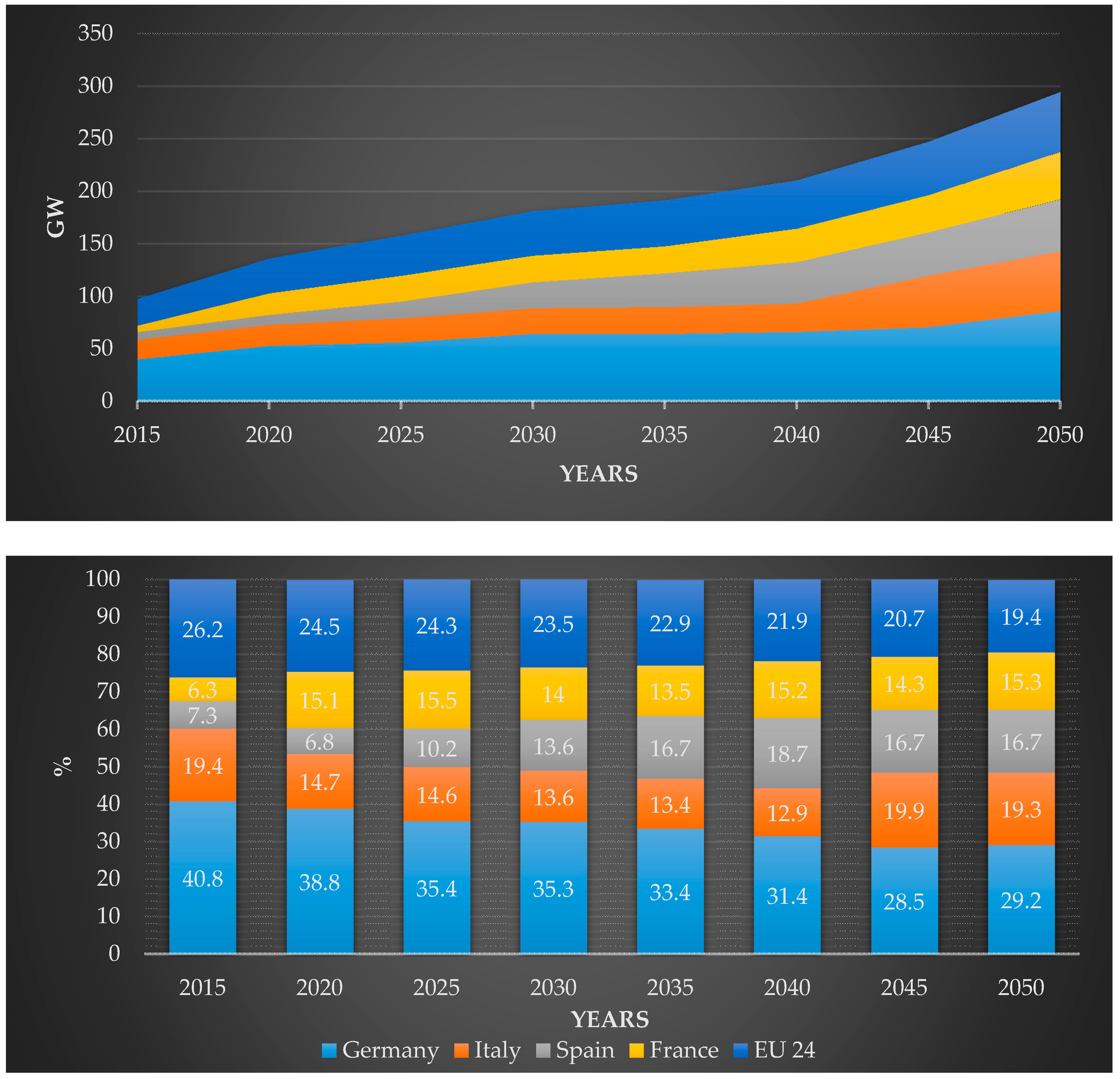
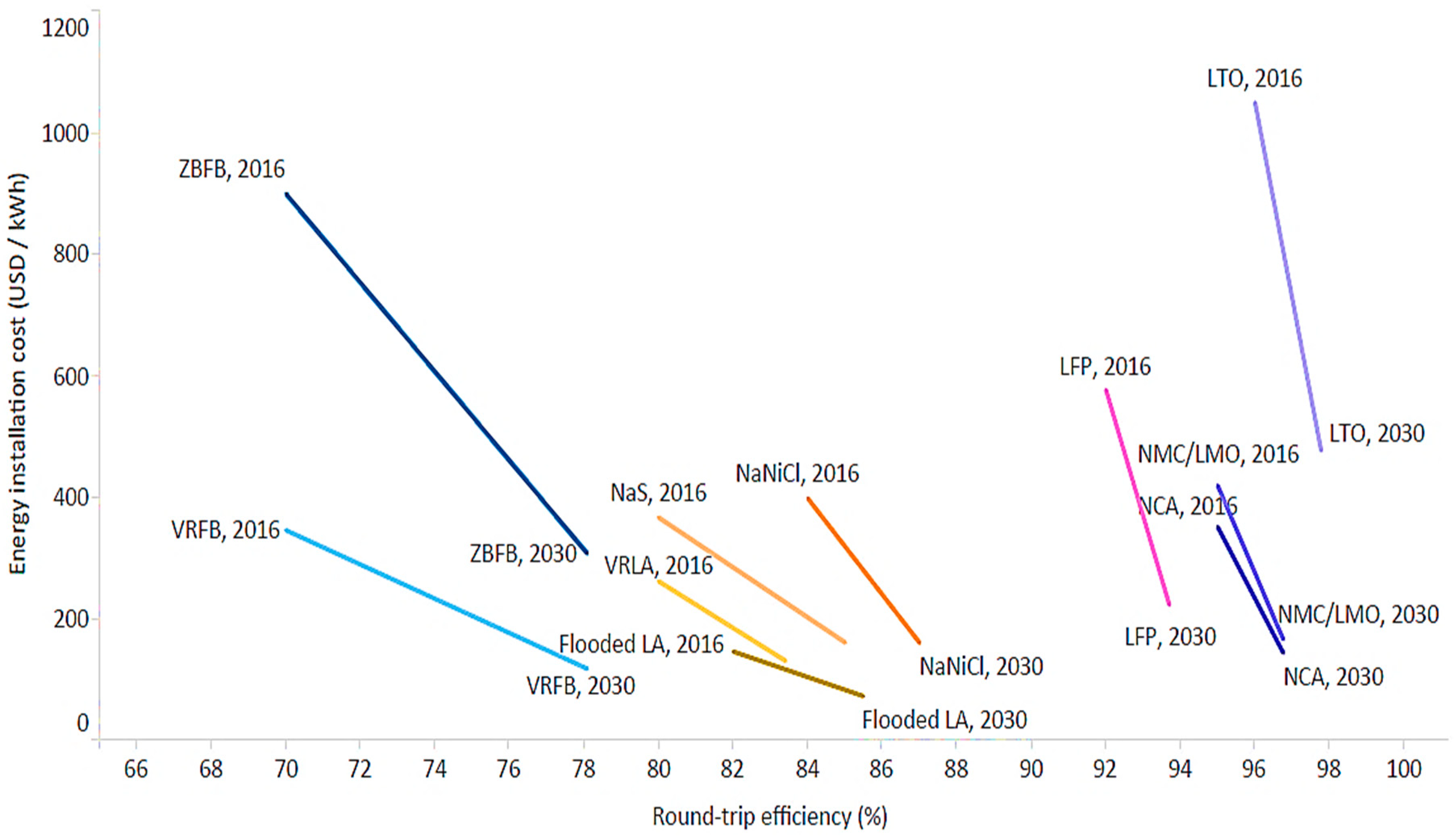
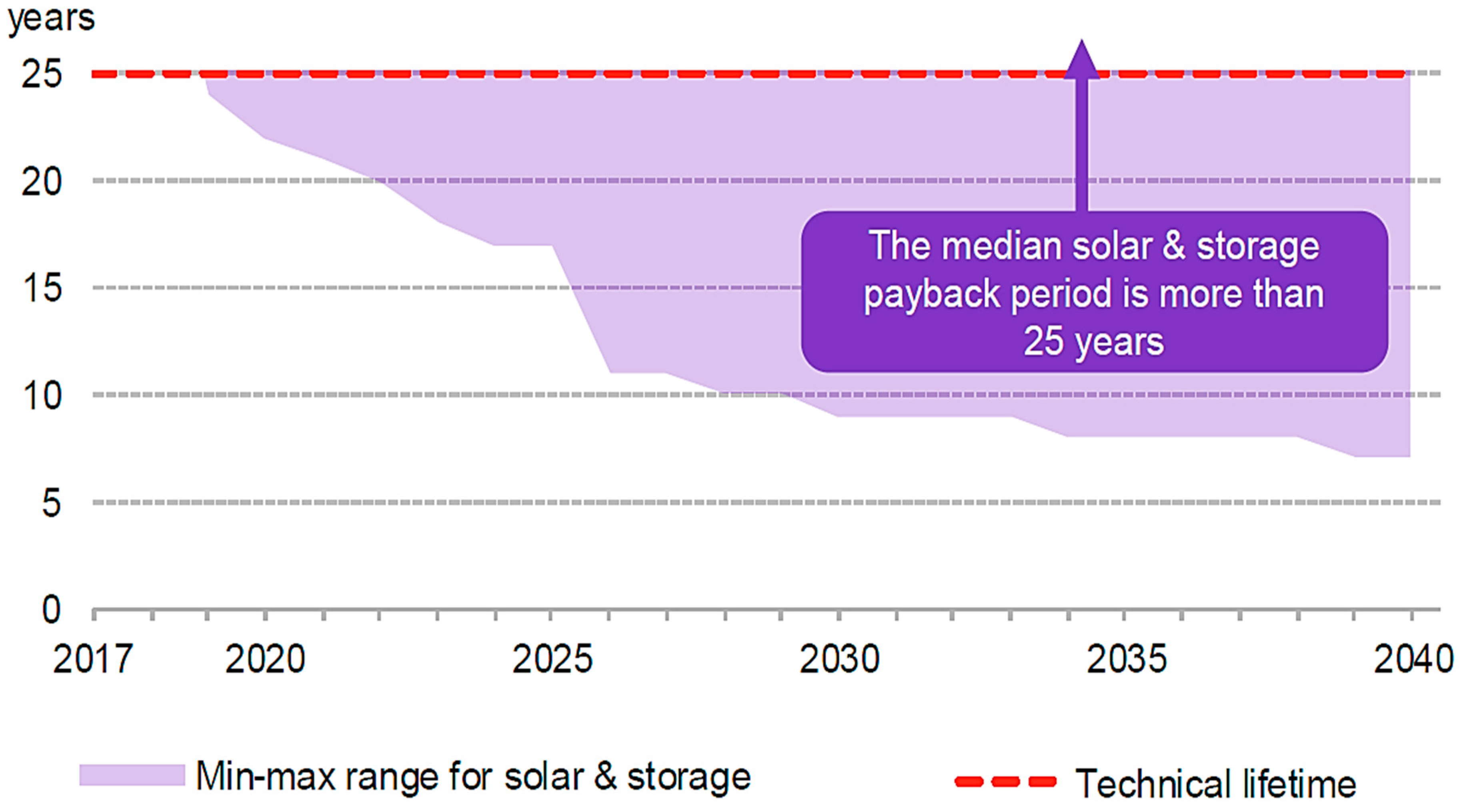
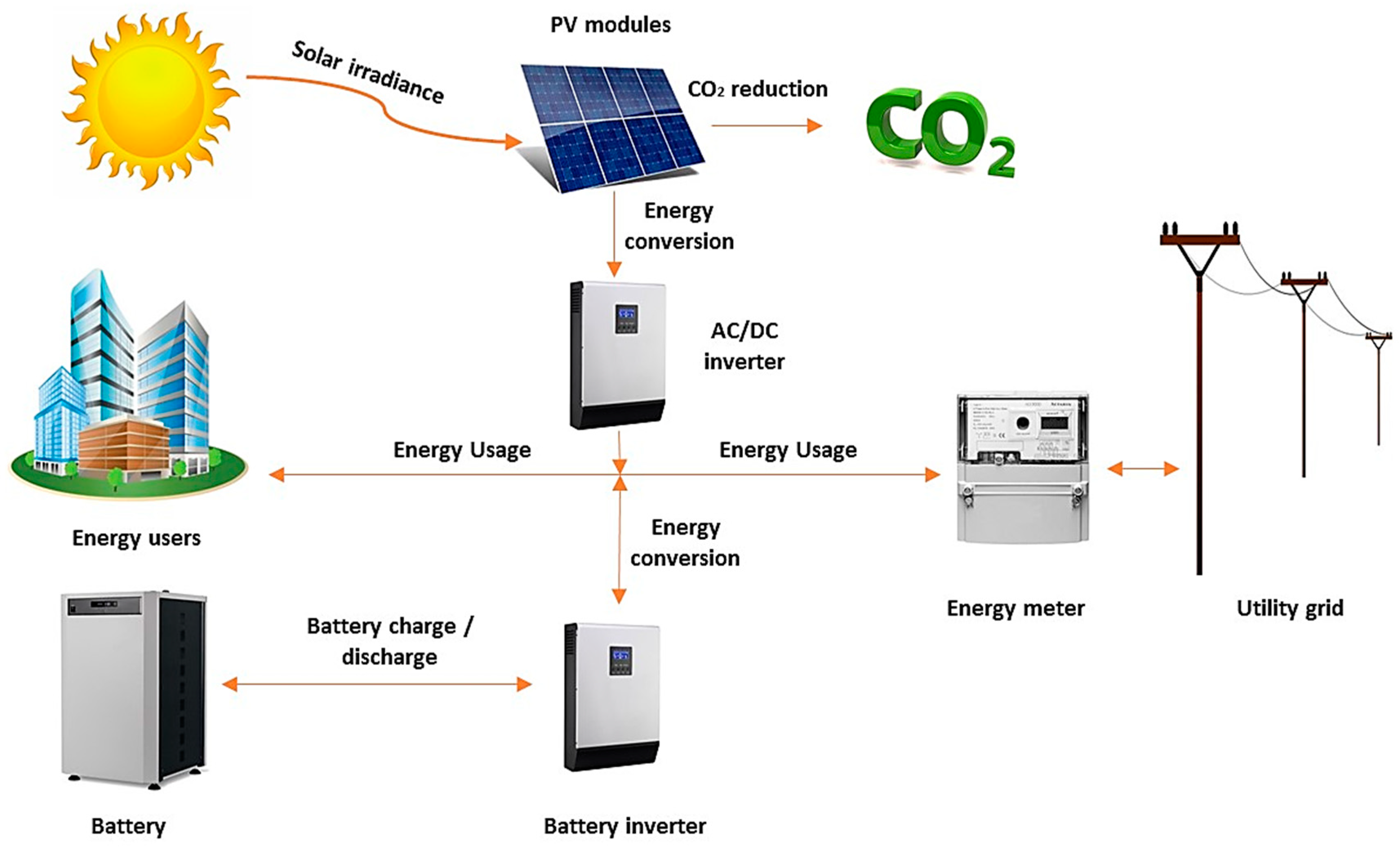
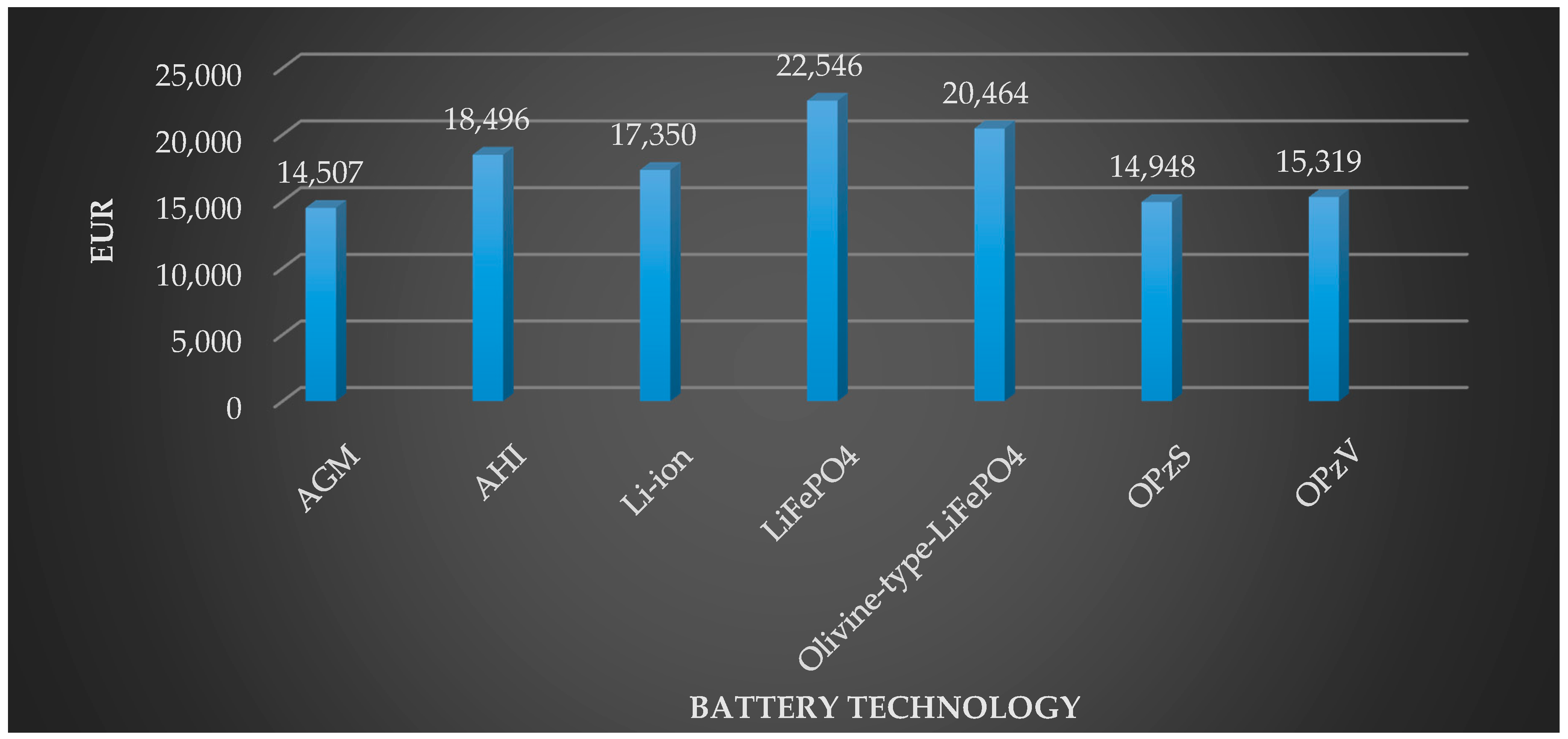
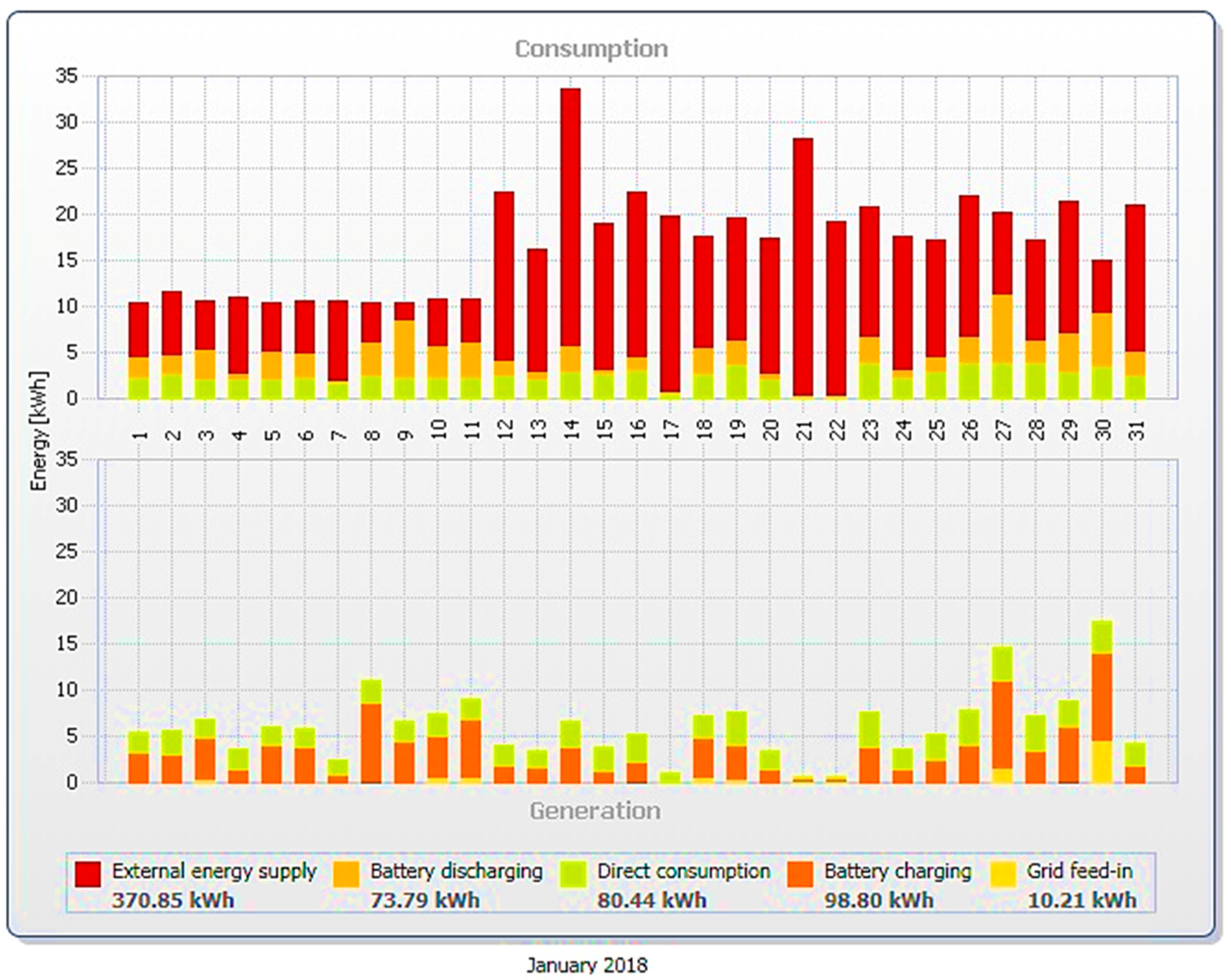
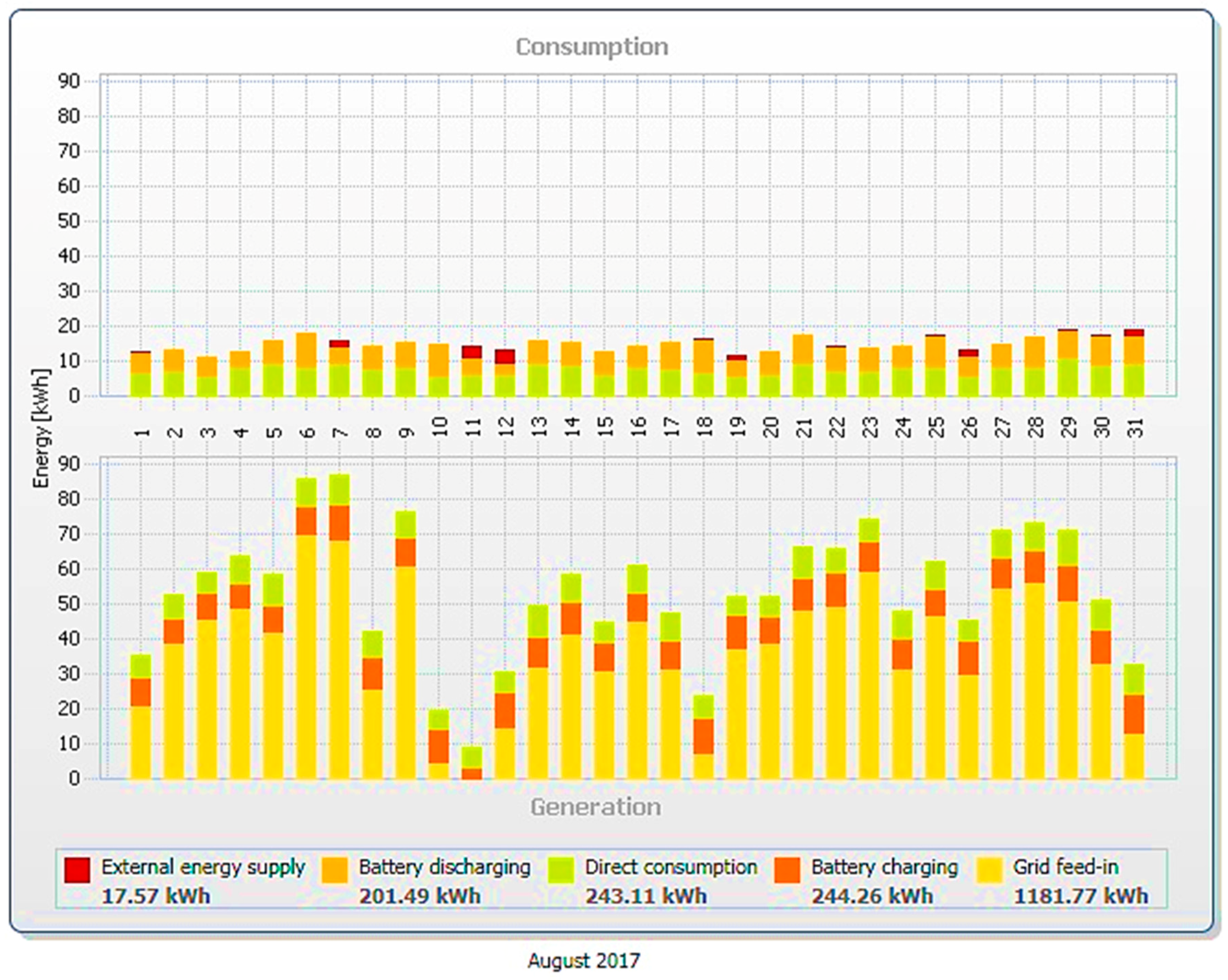
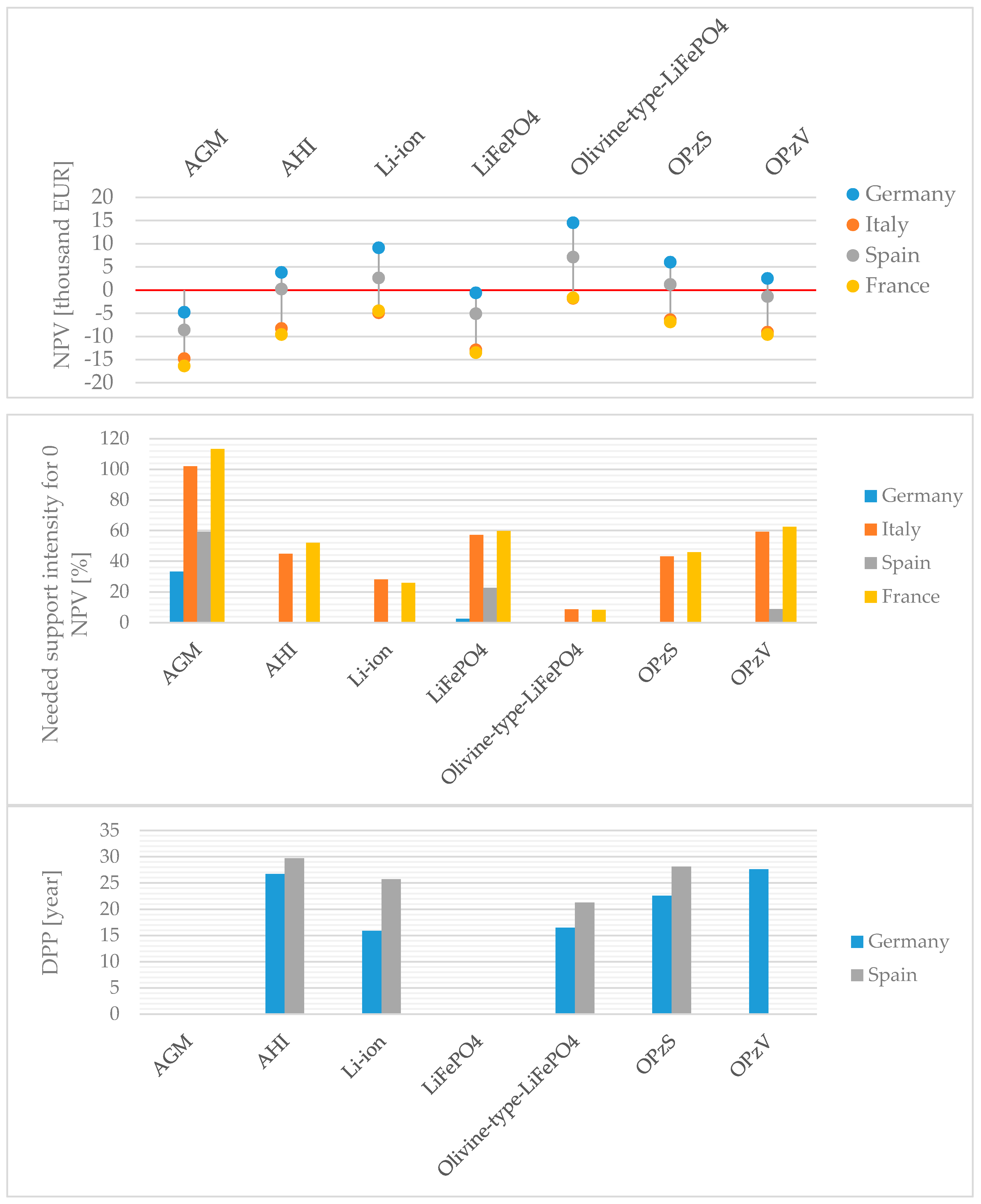
| Subject | World | Germany | Italy | Spain | France |
|---|---|---|---|---|---|
| Average min. and max. global horizontal irradiation by country (kWh/m2/year) | 800–2800 | 950–1250 | 950–1850 | 1150–1950 | 1050–1700 |
| Average min. and max. electric energy production of 1 kW PV system by country (kWh/year) | - | 1080–1150 | 1100–1800 | 1170–1790 | 1110–1630 |
| Selected city | Munich | Naples | Madrid | Toulouse | |
| Average global horizontal irradiation by city (kWh/m2/year) | 1200 | 1600 | 1800 | 1350 | |
| Real average electric energy production of 1 kW PV system by city (kWh/year) | 1122 | 1407 | 1482 | 1374 |
| Energy on PV module (%) | 100 | ||||||
| System loss, PV inverter, grid (%) | 90.3 | ||||||
| Battery technology | AGM | AHI | Li-ion | LiFePO4 | Olivine-type-LiFePO4 | OPzS | OPzV |
| Average PV battery efficiency (%) | 89 | 90 | 92 | 95 | 98 | 92 | 92 |
| System loss, PV inverter, battery inverter, battery, battery inverter, grid (%) | 73.0 | 73.8 | 75.5 | 77.9 | 80.4 | 75.5 | 75.5 |
| Depth of discharge (DOD) (%) | 80 | 100 * | 80 | 80 | 100 * | 80 | 80 |
| Average cycle stability based on depth of discharge (DOD) (cycles) | 700 | 3000 | 6000 | 6000 | 10,000 * | 1600 | 1300 |
| Average energy storage capacity change after 1 charge/discharge (%) | 0.057 | 0.01 | 0.005 | 0.0033 | 0.0029 | 0.025 | 0.0308 |
| Cost of 1 kWh nominal battery capacity in 2018 (EUR/kWh) | 213 | 713 | 574 | 1223 | 963 | 275 | 322 |
| Germany | Italy | Spain | France | |
|---|---|---|---|---|
| Average electricity consumption of households/2014/capita (kWh) | 1586 | 1074 | 1530 | 2197 |
| Average electricity consumption of households/2014/4 persons (kWh) | 6344 | 4296 | 6120 | 8788 |
| Rate of average inflation (2014–2017) (%) | 0.92 | 0.36 | 0.28 | 0.44 |
| Bond yield interest rate, 07 May 2018 (%) | 1.23 | 2.93 | 2.42 | 1.66 |
| Typical delivery price for electric energy in the case of a 5 kW system in 2017 (EURO cent/kWh) * | 12.7 | 17.1 | 15.04 | 18.48 |
| Household electricity prices including all taxes and levies in 2017 (EURO cent/kWh) | 30.5 | 21.4 | 23.0 | 16.9 |
| Maintenance Costs (Thousand EUR) | AGM | AHI | Li-ion | LiFePO4 | Olivine-Type-LiFePO4 | OPzS | OPzV |
|---|---|---|---|---|---|---|---|
| Germany | 30.9 | 20.6 | 12.9 | 19.2 | 7.4 | 17.5 | 20.9 |
| Italy | 28.5 | 18.8 | 11.7 | 17.4 | 6.8 | 16.1 | 19.2 |
| Spain | 28.1 | 18.6 | 11.6 | 17.1 | 6.7 | 15.9 | 18.9 |
| France | 28.8 | 19.1 | 11.9 | 17.6 | 6.9 | 16.3 | 19.4 |
© 2018 by the authors. Licensee MDPI, Basel, Switzerland. This article is an open access article distributed under the terms and conditions of the Creative Commons Attribution (CC BY) license (http://creativecommons.org/licenses/by/4.0/).
Share and Cite
Zsiborács, H.; Hegedűsné Baranyai, N.; Vincze, A.; Háber, I.; Pintér, G. Economic and Technical Aspects of Flexible Storage Photovoltaic Systems in Europe. Energies 2018, 11, 1445. https://doi.org/10.3390/en11061445
Zsiborács H, Hegedűsné Baranyai N, Vincze A, Háber I, Pintér G. Economic and Technical Aspects of Flexible Storage Photovoltaic Systems in Europe. Energies. 2018; 11(6):1445. https://doi.org/10.3390/en11061445
Chicago/Turabian StyleZsiborács, Henrik, Nóra Hegedűsné Baranyai, András Vincze, István Háber, and Gábor Pintér. 2018. "Economic and Technical Aspects of Flexible Storage Photovoltaic Systems in Europe" Energies 11, no. 6: 1445. https://doi.org/10.3390/en11061445
APA StyleZsiborács, H., Hegedűsné Baranyai, N., Vincze, A., Háber, I., & Pintér, G. (2018). Economic and Technical Aspects of Flexible Storage Photovoltaic Systems in Europe. Energies, 11(6), 1445. https://doi.org/10.3390/en11061445





